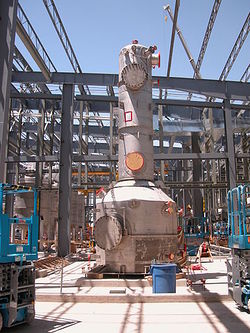Air pollution control devices

Air pollution control devices are a series of devices that work to prevent a variety of different pollutants, both gaseous and solid, from entering the atmosphere primarily out of industrial smokestacks. These control devices can be separated into two broad categories - devices that control the amount of particulate matter escaping into the environment and devices that control acidic gas emissions. It is important to understand that the extraction methods for each specific type of pollutant can differ, so the only the major methods are discussed. Although complex, these devices have shown to be effective in the past with the overall levels of emissions for many pollutants dropping with the implementation of these control devices.
To look at data showing how the emission levels of a variety of pollutants has changed over time, click here.
Particulate Control
Specific machinery is used to remove particulate matter from flue gases. Much of this separation uses physical means of separation and not chemical separation techniques simply because particulate matter is large enough to be "caught" in this manner. Below are some of the basic ways that particulate matter can be extracted.
Electrostatic Precipitators
An electrostatic precipitator is a type of filter that uses static electricity to remove soot and ash from exhaust fumes before they exit the smokestacks.[2] Unburned particles of carbon in smoke are pulled out of the smoke by using static electricity in the precipitators, leaving clean, hot air to escape the smokestacks.[2] It is vital to remove this unreacted carbon from the smoke, as it can damage buildings and harm human health - especially respiratory health.
Cyclone Separators
A cyclone separator is a separation device that uses the principle of inertia to remove particulate matter from flue gases.[3] In these separators, dirty flue gas enters a chamber containing a vortex, similar to a tornado. Because of the difference in inertia of gas particles and larger particulate matter, the gas particles move up the cylinder while larger particles hit the inside wall and drop down. This separates the particulate matter from the flue gas, leaving cleaned flue gas.
Fabric Filters
Fabric filters are one fairly simple method that can be used to remove dust from flue gases. In some gases they can also remove acidic gases if they utilize basic compounds. This method simply uses some sort of fabric - generally felt is used as a woven cloth would allow dust to make its way through - is placed so that flue gasses must pass through it before exiting the smokestacks.[4] When the gas passes through, dust particles are trapped in the cloth.
Gas Control
More intense chemical methods of separation are generally required to separate polluting gases from the flue gas. However, this extraction is important as many acidic gases in flue gas contribute to acid rain. Below are some of the basic ways that gases can be extracted.
Scrubbers
Scrubbers are a type of system that is used to remove harmful materials from industrial exhaust gases before they are released into the environment. These pollutants are generally gaseous, and when scrubbers are used to specifically remove SOx it is referred to as flue gas desulfurization. There are two main types of scrubbers, wet scrubbers and dry scrubbers. The main difference is in the type of material used to remove the gases. By removing acidic gases from the exhaust before it is released into the sky, scrubbers help prevent the formation of acid rain.[5]
Incineration
Incineration is used to convert VOC emissions into carbon dioxide and water through combustion. The incineration generally takes place in a specialized piece of equipment known as an afterburner, which is built to create the conditions necessary for complete combustion (such as sufficient burn time and a high temperature).[6] Additionally, the incinerated gas must be mixed to ensure complete combustion.
Carbon Capture
Carbon dioxide can theoretically also be captured and stored underground or in forests and oceans to prevent it from entering the atmosphere. Carbon capture and storage refers to the process of capturing this carbon dioxide and storing it below ground, pumping it into geologic layers. This process is rarely being used, but is talked about extensively as a way to limit greenhouse gas emissions leading to climate change.
References
- ↑ Wikimedia Commons. (July 14, 2015). Chemical Scrubber [Online]. Available: https://commons.wikimedia.org/wiki/File:Pueblo_Chemical_Agent_-_Scrubber.jpg#/media/File:Pueblo_Chemical_Agent_-_Scrubber.jpg
- ↑ 2.0 2.1 Chris Woodford. (July 24, 2015). How Does an Electrostatic Precipitator Work? [Online]. Available: http://www.explainthatstuff.com/electrostaticsmokeprecipitators.html
- ↑ R. Wolfson. Energy, Environment and Climate, 2nd ed. New York, U.S.A.: Norton, 2012
- ↑ US EPA. (July 24, 2015). Air Pollution Control [Online]. Available: http://www.epa.gov/ttnchie1/conference/ei11/stationarysource/hochhauser.pdf
- ↑ WiseGeek. (July 24, 2015). What is a Scrubber System? [Online]. Available: http://www.wisegeek.com/what-is-a-scrubber-system.htm
- ↑ Ashok Kumar. (July 24, 2015). Air Pollution Control Devices [Online]. Available: http://www.eng.utoledo.edu/~akumar/IAP1/Pollution%20Control.htm

